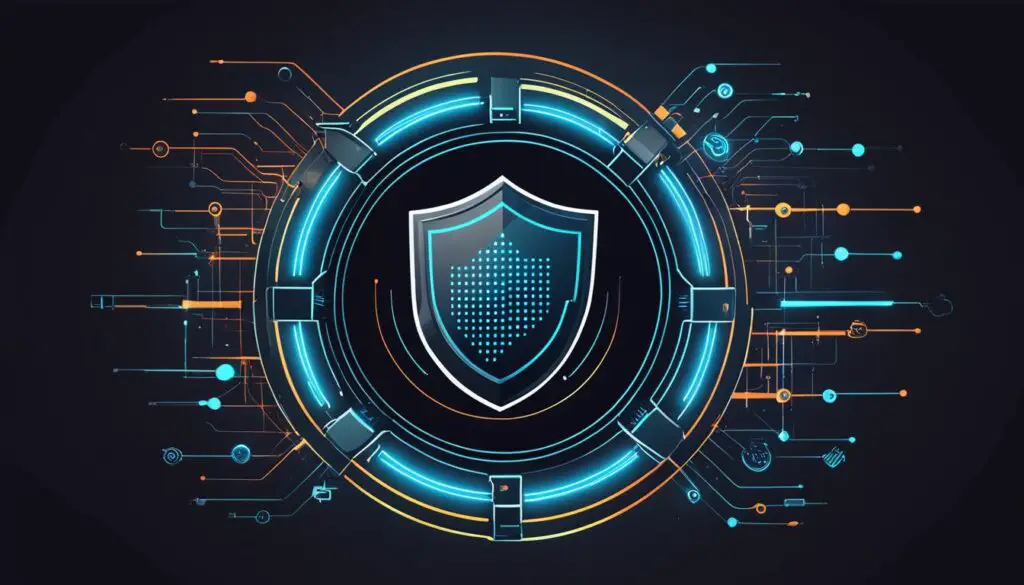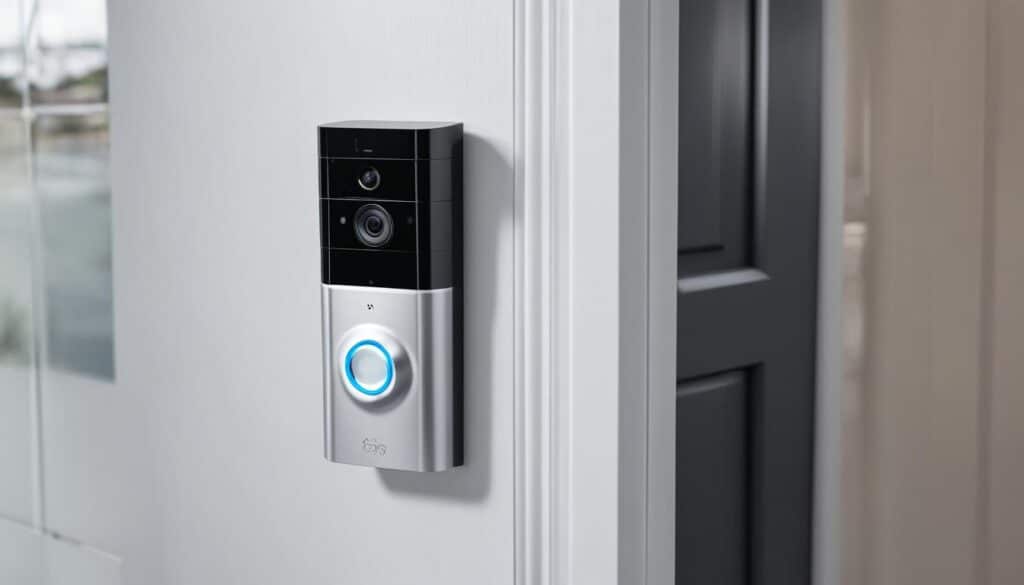If you’re new to the world of smart home security, you’ve come to the right place. In this guide, I will walk you through the basics of smart home security and help you safeguard your home for a secure lifestyle.
Smart home security is gaining popularity among homeowners because it offers convenience, peace of mind, and an extra layer of protection for your property. With a smart home security system, you can monitor and control your home from anywhere, ensuring that you are always connected and in control.
But where do you start as a beginner? Understanding the essential components of a smart home security system is the first step towards a secure home. From sensors to cameras, control panels, and mobile apps, these components work together to keep your home safe and protected.
Choosing the right smart home security equipment can be overwhelming, but don’t worry—I’ll provide you with valuable tips to make the selection process easier. By considering factors such as your home’s security needs, budget, compatibility, and ease of installation, you can make an informed decision.
Securing your smart home is vital to protect your privacy and prevent unauthorized access to your devices. I’ll share essential tips and tricks, like securing your Wi-Fi network, updating device firmware, and using two-factor authentication, to ensure your smart home remains safe and secure.
By following the basics of smart home security, you can enjoy a secure lifestyle and have peace of mind knowing that your home is protected. Let’s dive in and explore the world of smart home security together!
Table of Contents
Key Takeaways:
- Smart home security offers convenience, peace of mind, and an added layer of protection for your home.
- Understanding the components of a smart home security system is essential for beginners.
- Consider factors like security needs, budget, compatibility, and ease of installation when choosing smart home security equipment.
- Securing your smart home involves steps like securing your Wi-Fi network, updating device firmware, and using two-factor authentication.
- Implementing smart home security measures leads to a secure lifestyle and peace of mind.
Understanding the Components of a Smart Home Security System
A smart home security system comprises various components that work together to safeguard your home. These components include sensors, cameras, a control panel, and a mobile app.
Sensors play a vital role in detecting and alerting you to potential threats. For instance, motion sensors can detect movement in your home, while entry sensors notify you when doors or windows are opened. These sensors act as the first line of defense in your security system, providing valuable information to keep your home safe.
Cameras are essential for visual surveillance and allow you to monitor your home remotely. With smart cameras strategically placed around your property, you can keep an eye on important areas and receive real-time video feeds on your mobile device or computer. This level of visibility offers added peace of mind, especially when you’re away from home.
The control panel serves as the central hub of your smart home security system. It connects all the components, allowing them to communicate and work together seamlessly. From the control panel, you can easily arm and disarm your security system, customize settings, and receive notifications.
To conveniently manage your smart home security system, a mobile app is usually provided. This app empowers you to control and monitor your security system from anywhere, as long as you have an internet connection. Whether you want to check the status of your sensors or view live camera footage, the mobile app puts control at your fingertips.
Choosing the Right Smart Home Security Equipment
When it comes to smart home security, choosing the right equipment is essential. There are several factors you should consider to ensure you select the best options for your home. Let’s take a closer look at these factors:
Assess Your Specific Security Needs
Start by assessing your specific security needs. Consider the size of your property, the number of entry points, and any specific vulnerabilities that need to be addressed. This will help you determine the type and quantity of smart home security equipment required to safeguard your home.
Evaluate Your Budget
Next, evaluate your budget for smart home security equipment. Determine how much you are willing to invest in your system. Remember that investing in high-quality equipment is crucial for the long-term security and protection of your home.
Consider Compatibility and Ease of Installation
Compatibility is another important factor to consider. Ensure that the smart home security equipment you choose is compatible with other devices in your home. This will allow for seamless integration and enhanced functionality. Additionally, consider the ease of installation and use. Look for equipment that is user-friendly and can be easily set up without professional assistance.
Read Customer Reviews and Compare Brands
Lastly, take the time to read customer reviews and compare different brands and models of smart home security equipment. Customer reviews provide valuable insights into the performance and reliability of the equipment. Comparing brands and models will help you make an informed decision based on the features and benefits that are most important to you.
By considering these factors, you can choose the right smart home security equipment that meets your specific needs and provides you with the peace of mind you deserve.
Essential Tips for Securing Your Smart Home
Securing your smart home is crucial to protect your privacy and prevent unauthorized access to your devices. Here are some essential tips and tricks to ensure network security and safeguard your smart home:
- Secure your Wi-Fi network: Start by securing your Wi-Fi network with a strong, unique password. Avoid using default passwords and consider using a combination of alphanumeric characters, symbols, and both upper and lowercase letters. Regularly update your password to maintain security.
- Keep firmware updated: Regularly update the firmware of your smart home devices. Manufacturers often release updates that address security vulnerabilities. By keeping your devices up to date, you can patch any potential weaknesses in the system.
- Enable two-factor authentication: Whenever possible, enable two-factor authentication for your smart home devices and applications. This adds an extra layer of protection by requiring an additional verification step, such as a code sent to your mobile device, before granting access.
- Be cautious with third-party apps: When granting permissions to third-party apps, exercise caution and review the permissions being requested. Only grant access to the necessary functionalities and ensure that the app comes from a trusted source.
- Review privacy settings: Take the time to review and configure the privacy settings of your smart home devices and applications. Adjust the settings to your desired level of privacy, disabling features or data sharing that you are not comfortable with.
- Consider using a virtual private network (VPN): A virtual private network encrypts your internet traffic, adding an extra layer of security. By using a VPN, you can protect your data from potential eavesdroppers and ensure your online activities remain private.
Remember, taking proactive steps to secure your smart home is essential for maintaining network security and protecting your privacy. By following these tips and tricks, you can enjoy the convenience and peace of mind that smart home technology offers.

Implementing these essential tips and tricks will go a long way in securing your smart home and ensuring a protected and connected living environment.
Conclusion
Implementing smart home security measures is a smart investment for beginners. It provides peace of mind, added security, and the convenience of monitoring and controlling your home from anywhere. By understanding the components of a smart home security system, choosing the right equipment, and following essential tips for securing your smart home, you can create a secure and protected living environment.
Start your journey to a secure lifestyle today, with the basics of smart home security. With the right knowledge and equipment, you can enjoy the benefits of a smart home while ensuring the safety of your property and loved ones. Whether you’re a tech-savvy individual or a beginner, smart home security offers a seamless integration into your everyday life.
Don’t let your home security be a source of stress. Embrace the potential of smart home security to simplify your life and provide peace of mind. With smart home security basics, beginners and experienced homeowners alike can enjoy the convenience, security, and control that this technology brings. Safeguard your home and embark on a secure lifestyle for ultimate peace of mind.
FAQ
What is a smart home security system?
A smart home security system consists of various components, including sensors, cameras, a control panel, and a mobile app, all working together to protect your home.
What do sensors do in a smart home security system?
Sensors play a crucial role in detecting and alerting you to potential threats, such as motion or entry sensors that detect when doors or windows are opened.
How do cameras contribute to a smart home security system?
Cameras provide visual surveillance and allow you to monitor your home remotely, offering an added layer of security.
What is the role of a control panel in a smart home security system?
The control panel serves as the hub of your system, allowing you to manage and control your entire smart home security system.
How does a mobile app enhance a smart home security system?
The mobile app gives you the ability to control and monitor your smart home security system from anywhere, providing convenience and peace of mind.
What factors should I consider when choosing smart home security equipment?
Factors to consider include your specific security needs, budget, compatibility with other devices, ease of installation and use, and reading customer reviews to compare different brands and models.
How can I secure my smart home?
Secure your smart home by securing your Wi-Fi network with a strong password, regularly updating device firmware, enabling two-factor authentication, being cautious with app permissions, reviewing privacy settings, and considering the use of a virtual private network (VPN).
Why should I invest in a smart home security system as a beginner?
Investing in a smart home security system provides peace of mind, added security, and the convenience of monitoring and controlling your home from anywhere, creating a secure and protected living environment.


